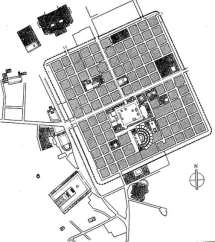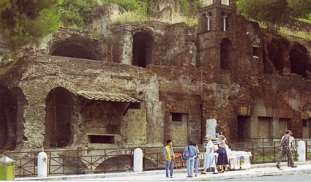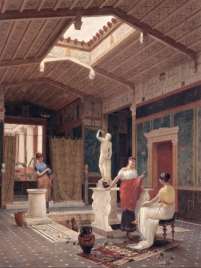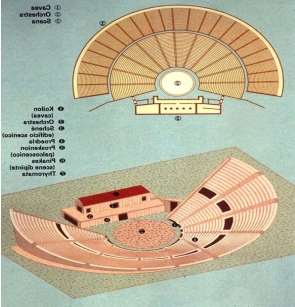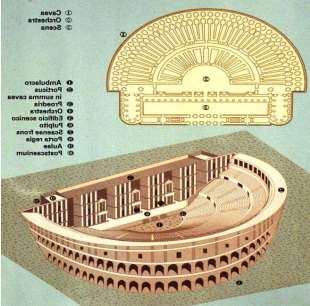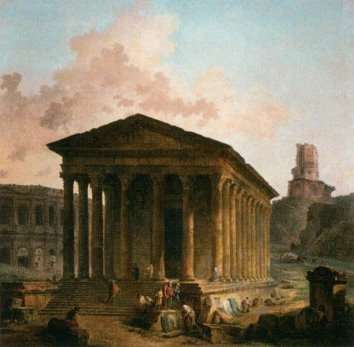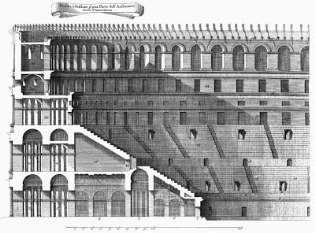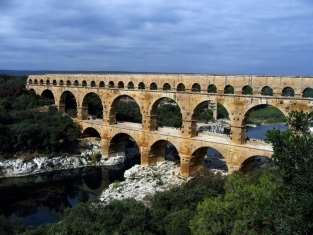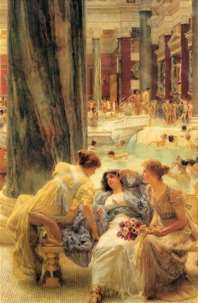Analysis of Ancient Roman Architecture
| ✅ Paper Type: Free Essay | ✅ Subject: Architecture |
| ✅ Wordcount: 2399 words | ✅ Published: 2nd May 2018 |
Ancient Rome is well recognised for its potential to produce large, dense and complex network of infrastructure ranging from roads, aqueducts, bridges, baths, and temples. The Romans were impressive builders and some of the structures built by the Romans that still stand up to this day exhibit this. Large infrastructure was one of the fundamental aspects that allowed the Roman Empire to maintain its expansive territory; roads allowing the free movement of goods, information and troops, the sewers and freshwater systems enabling the growth of large populations. Thus, with these benefits, the Roman empire began to flourish and sparked a golden age of technological advancement and architectural development.
Under the Roman empire, city development followed the grid plan based framework adopted from late Greek cities of the Hellenistic period. Roman cities had two major roads, the Cardo Maximus, the main street running through the north-south and the Decumanus, running east-west, serving as a secondary street, emphasised in the ancient Roman city of Timgad (figure 1), which was a common aspect of Roman cities. In essence, the Cardo Maximus and Decumanus played an integral part of city planning, but also served as a central hub for economic life and business.
|
|
|
Figure 1: The city of Timgad in Algeria (Marten Kuilman 2010) |
Furthermore, the Roman grid-based city plan transitioned towards an urban plan by the first century B.C.E. However, it was not planned entirely in advance during the development of Rome. On the other hand, by superseding grid-based plan, an urban plan was a more flexible solution resulting in a more elaborate and organic ‘plan’ that allowed Rome to expand, improve and grow in splendour (Evans, 2017, p.24-5).
Thus theatres, public buildings, basilicas, temples, libraries, and amphitheatres were sprinkled all across the urban fabric of the city so that every building was surrounded by a public structure (Kostof, 1991, p.214).
Albeit, Rome did suffer from urban issues, most of which was the gap between the wealthy and poor. The vast majority of Roman citizens were poor and lived in multi-storey flats or apartments known as Insulae (figure 2), which were simplistic buildings that only provided at best a maximum of 2 rooms with no indoor plumbing; therefore, the poor had to commute to public baths to get a supply of water.
|
|
|
Figure 2: Remains of a insula in the Capitol hill, in Rome (II century a. C.) (Peter Collony and Hazel dodge 1998) |
On the other hand, the rich lived in single storey private houses called Domus, consisting of multiple rooms, lavishly laid out walls, gardens and courtyards surrounding the atrium (figure 3) which was the large central hall of the Domus.
|
|
|
Figure 3: A Pompeian Interior oil on panel Dahesh Museum of Art (Luigi Bazzani 1882) |
The Roman forum was an oblong space adapted from the Greek agora, located near the intersection of the Cardo Maximus and Decumanus whereas the theatre and amphitheatre were located at the perimeter of the city, wrapped around by fortified city walls. The forum was mainly composed of public buildings such as baths, temples of worship, civic centres and administrative buildings, enclosed by colonnades and either a town hall or a basilica. This was because of the Roman propensity to enclose public buildings, for example, the classical Greek theatre’s evolution that initially began as an open structure (figure 4), however, it was improved upon by the Romans into an enclosed theatre (figure 5) through the combination of the auditorium and stage (Wheeler, 1964, pp.111-2).
|
|
|
|
Figure 4: Greek theatre (Twinningblog 2008) |
Figure 5: Greek theatre (Twinningblog 2008) |
Public buildings were adorned with sculptures, paintings, and fountains that were used as a source of civic pride for the Roman public. As a result, the forum became the focal point of business, social existence and the centre of political debate amongst the people of the empire and politicians.
Get Help With Your Essay
If you need assistance with writing your essay, our professional essay writing service is here to help!
Find out more about our Essay Writing Service
Roman temples such as the Maison Carrée, Nimes (16 B.C.E.) (figure 6) were considered the home of the gods as Roman religion played an important part of Roman society. People went to temples to worship and pray to a multitude of deities such as Jupiter, Juno, Venus and Mars amongst many other main gods.
|
|
|
Figure 6: The Maison Carée, the Arenas and the Magne Tower in Nimes (Hubert Robert 1787) |
The Roman theatre, amphitheatre and Hippodrome provided Roman society with an abundance of entertainment. Amphitheatres such as the Coliseum (figure 7) was the home of violence presented in many forms. Entertainment ranged from gladiatorial fights, executions, wild animal fights and the occasional naval battles that required the Coliseum to be flooded, in front of 50,000 spectators from different social classes arranged on stands that the Coliseum was able to house. Therefore, the Coliseum became a public spectacle to a society that loved blood and could decide the fate of the loser but also reflected the social stratification of Roman society.
|
|
|
Figure 7: Colosseum: Cross-section (Granger 2014) |
Whereas the Circus Maximus offered a different kind of entertainment that was chariot racing in front of a maximum capacity 250,000 people that were as famous as the events held at the Coliseum. Even though society loved watching fights and races, however, some members of the public were opposed to the idea of watching fighters die for entertainment at the Coliseum. Thus, the theatre was the ideal alternative to the Coliseum and the Circus Maximus, where plays were held.
Roman baths were considered as an essential requirement for day-to-day life in Rome. The Roman practice of Bathing was initially a Greek tradition; that gained popularity amongst Roman society during the second century B.C.E. Moreover, due to the popularity that baths gained, it highlighted the requirement for a centrally based bath complex within the urban structure of every Roman city as more Roman cities began to emerge, epitomised by the city of Bath that gained its name for its Roman bath complex.
By the early third century C.E., Eleven main aqueducts supplied the city of Rome on average 190,000 cubic meters of water daily to homes, public and private baths, which had to be provided and distributed via a system of pipes made from either clay or lead. The aqueduct in Segovia, Spain, built in the second Century CE is still being used today. Whereas the Pont du Gard that is part of the aqueduct de Nimes (figure 8) is probably regarded by many architects and engineers as the most impressive aqueduct built by the Romans, standing at a total height of 48.77 metres, shows the skill and complexity that Roman engineers were able to attain.
|
|
|
Figure 8: Pont du Gard (Emanuele 2007) |
Despite water being supplied to Roman baths and houses via a system of pipes, fees were charged in accordance to the pipe’s size, the larger the pipe, the higher the tax. Therefore, for personal hygiene, Roman citizens went to local baths such as the baths of Caracalla (figure 9), known for its complex functionality, sophistication and immense size. Romans were able to bathe for a small fee; however, Roman baths also became areas of social interchange where gatherings gossiped and conversed about current events or to discuss business matters while getting clean at the same time.
|
|
|
Figure 9: The Baths Of Caracalla (Sir Lawrence Alma-Tadema 1899) |
Some Roman structures have survived the test of time and still reside within the urban fabric today, many of these have been changed, repurposed and modernised into urban forms within the city and have contributed to the formation of cities. The Roman amphitheatre turned into a public circular square in Lucca, Diocletian palace that became the centre of Split in Croatia, which was a palace with walls that became the ‘downtown’ of the city since the collapse of the roman empire. Furthermore, piazza Navona was built on the site of the stadium of Domitian, the amphitheatre and basilica having significant influence on Western architecture.
To conclude the Romans were a sociable society that transformed the legacy of Greek architecture into their vision, a vision turned into an art form and embodied in many cities today. Despite Roman architecture being around for millennia, it is one of the most influential architectural styles that became a source of inspiration for many architects throughout time.
Bibliography:
Kuilman, M. (2010). QA596 – The city of Timgad in Algeria. [image] Available at: https://www.flickr.com/photos/quadralectics/4361584827/in/photostream/ [Accessed 8 Jan. 2017].
Collony, P. and Dodge, H. (1998). Remains of a insula in the Capitol hill, in Rome (II century a. C.). Photography from CONNOLLY, Peter y DODGE, Hazel: La Ciudad Antigua. La vida en la Atenas y Roma clásicas, Madrid, 1998.. [image] Available at: http://www.catedu.es/aragonromano/images/insulac2.jpg [Accessed 8 Jan. 2017].
Bazzani, L. (1882). : A Pompeian Interior oil on panel Dahesh Museum of Art. [image] Available at: http://www.nga.gov/exhibitions/2008/pompeii/images/atrium_int_large.jpg [Accessed 8 Jan. 2017].
Twinningblog, (2008). Greek Theatre. [image] Available at: https://twinningblog.files.wordpress.com/2008/03/t-greco.jpg [Accessed 8 Jan. 2017].
Twinningblog, (2008). Roman theatre. [image] Available at: https://twinningblog.files.wordpress.com/2008/03/roman-theatre1.jpg [Accessed 8 Jan. 2017].
Robert, H. (1787). The Maison Carée, the Arenas and the Magne Tower in Nimes. [image] Available at: https://upload.wikimedia.org/wikipedia/commons/thumb/7/7f/Hubert_Robert_-_The_Maison_Car%C3%A9e%2C_the_Arenas_and_the_Magne_Tower_in_Nimes_-_WGA19601.jpg/612px-Hubert_Robert_-_The_Maison_Car%C3%A9e%2C_the_Arenas_and_the_Magne_Tower_in_Nimes_-_WGA19601.jpg [Accessed 8 Jan. 2017].
Granger, (2014). Colosseum: Cross-section. [image] Available at: http://2.bp.blogspot.com/-icVVTe7uLeA/TyHbBA9tasI/AAAAAAAAE7k/UWnt4CwKQgc/s400/colosseum-cross-section.jpg [Accessed 8 Jan. 2017].
Emanuele, (2007). Pont du Gard. [image] Available at: https://www.flickr.com/photos/11432907@N00/1566294527 [Accessed 8 Jan. 2017].
Alma-Tadema, L. (1899). The Baths Of Caracalla. [image] Available at: https://uploads1.wikiart.org/images/alma-tadema-lawrence/the-baths-of-caracalla-1899.jpg!Large.jpg [Accessed 8 Jan. 2017].
Dudley, D. (1991). Roman society. Harmondsworth: Penguin.
Evans, G. (2017). Cultural planning : an urban renaissance. London: Routledge.
Gates, C. (2004). The archaeology of urban life in the ancient Near East and Egypt, Greece, and Rome. London: Routledge.
Hodge, A. (2002). Roman aqueducts & water supply. London: Duckworth.
Kostof, S. and Richard, T. (1991). The City Shaped: Urban Patterns and Meanings Through History. London: Thames and Hudson.
Macaulay, D. (1975). City : A Story of Roman Planning and Construction. London: Collins.
Perez de Arce, R. (2017). Urban Transformations and the Architecture of Additions. [ebook] London: Routledge, p.xvi-ii. Available at: https://books.google.co.uk/books?id=CX09BAAAQBAJ&printsec=frontcover#v=onepage&q&f=false [Accessed 3 Jan. 2017].
Rykwert, J. (1976). The idea of a town. Princeton, N.J.: Princeton University Press.
Vitruvius Pollio., Schofield, R. and Tavernor, R. (2009). On architecture. London: Penguin Books.
Watkin, D. (2009). The Roman Forum. Cambridge, Mass.: Harvard University Press.
Wheeler, M. (1964). Roman art and architecture. London: Thames and Hudson.
Yourcenar, M. (2000). Memoirs of Hadrian. London: Penguin.
Cite This Work
To export a reference to this article please select a referencing stye below:
Related Services
View allDMCA / Removal Request
If you are the original writer of this essay and no longer wish to have your work published on UKEssays.com then please click the following link to email our support team::
Request essay removal